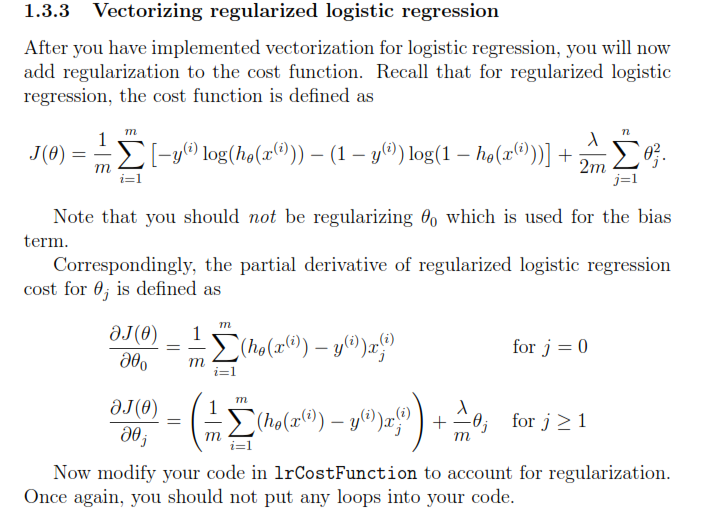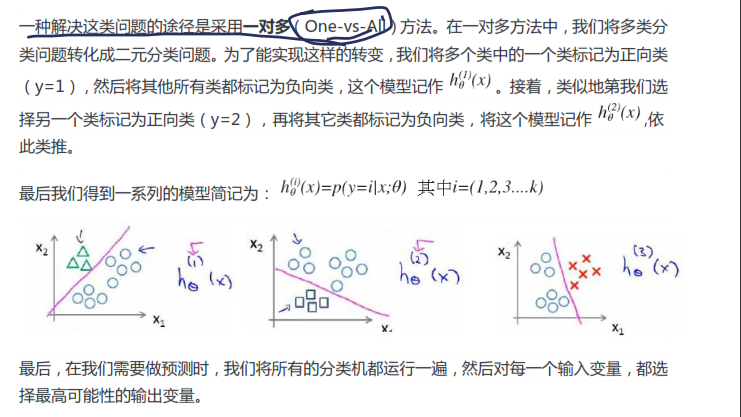Andrew Ng coursera上的《机器学习》ex3
2016-08-22 16:30
274 查看
Andrew Ng coursera上的《机器学习》ex3
按照课程所给的ex3的文档要求,ex3要求完成以下几个计算过程的代码编写:| exerciseName | description |
|---|---|
| IrcostFunction.m | logistics regression cost function |
| oneVSall.m | train one-vs-all muti-class classifier |
| predictOneVsAll.m | prediction function |
| predict.m | neutral network prediction function |
1. lrcostFunction.m
Octave代码如下:表达式如下:

function [J, grad] = lrCostFunction(theta, X, y, lambda) %LRCOSTFUNCTION Compute cost and gradient for logistic regression with %regularization % J = LRCOSTFUNCTION(theta, X, y, lambda) computes the cost of using % theta as the parameter for regularized logistic regression and the % gradient of the cost w.r.t. to the parameters. % Initialize some useful values m = length(y); % number of training examples % You need to return the following variables correctly J = 0; grad = zeros(size(theta)); % ====================== YOUR CODE HERE ====================== % Instructions: Compute the cost of a particular choice of theta. % You should set J to the cost. % Compute the partial derivatives and set grad to the partial % derivatives of the cost w.r.t. each parameter in theta % % Hint: The computation of the cost function and gradients can be % efficiently vectorized. For example, consider the computation % % sigmoid(X * theta) % % Each row of the resulting matrix will contain the value of the % prediction for that example. You can make use of this to vectorize % the cost function and gradient computations. % % Hint: When computing the gradient of the regularized cost function, % there're many possible vectorized solutions, but one solution % looks like: % grad = (unregularized gradient for logistic regression) % temp = theta; % temp(1) = 0; % because we don't add anything for j = 0 % grad = grad + YOUR_CODE_HERE (using the temp variable) % hx=sigmoid(X*theta); J=-(y'*log(hx)+(1-y)'*log(1-hx))/m+lambda/(2*m)*sum(theta(2:end,:).^2); theta(1)=0; grad=1/m*X'*(hx-y)+lambda/m*theta; % ============================================================= grad = grad(:); end
以上的代码是根据逻辑回归函数中的代价函数和梯度下降的思想进行编写的。
2.oneVSall.m
要求:根据one-vs-all的思想编写相应的Octave代码。one-vs-all的思想如下图:
function [all_theta] = oneVsAll(X, y, num_labels, lambda)
%ONEVSALL trains multiple logistic regression classifiers and returns all
%the classifiers in a matrix all_theta, where the i-th row of all_theta
%corresponds to the classifier for label i
% [all_theta] = ONEVSALL(X, y, num_labels, lambda) trains num_labels
% logisitc regression classifiers and returns each of these classifiers
% in a matrix all_theta, where the i-th row of all_theta corresponds
% to the classifier for label i
% Some useful variables
m = size(X, 1);
n = size(X, 2);
% You need to return the following variables correctly
all_theta = zeros(num_labels, n + 1);
% Add ones to the X data matrix
X = [ones(m, 1) X];
% ====================== YOUR CODE HERE ======================
% Instructions: You should complete the following code to train num_labels
% logistic regression classifiers with regularization
% parameter lambda.
%
% Hint: theta(:) will return a column vector.
%
% Hint: You can use y == c to obtain a vector of 1's and 0's that tell use
% whether the ground truth is true/false for this class.
%
% Note: For this assignment, we recommend using fmincg to optimize the cost
% function. It is okay to use a for-loop (for c = 1:num_labels) to
% loop over the different classes.
%
% fmincg works similarly to fminunc, but is more efficient when we
% are dealing with large number of parameters.
%
% Example Code for fmincg:
%
% % Set Initial theta
% initial_theta = zeros(n + 1, 1);
%
% % Set options for fminunc
% options = optimset('GradObj', 'on', 'MaxIter', 50);
%
% % Run fmincg to obtain the optimal theta
% % This function will return theta and the cost
% [theta] = ...
% fmincg (@(t)(lrCostFunction(t, X, (y == c), lambda)), ...
% initial_theta, options);
%
options=optimset('GradObj','on','MaxIter',50);
for k=1:num_labels
initial_theta=zeros(n+1,1);
theta=fmincg(@(t)(lrCostFunction(t,X,(y==k),lambda)),initial_theta,options);
all_theta(k,:)=theta';
end
% =========================================================================
end3. predictOneVsAll.m
function p = predictOneVsAll(all_theta, X) %PREDICT Predict the label for a trained one-vs-all classifier. The labels %are in the range 1..K, where K = size(all_theta, 1). % p = PREDICTONEVSALL(all_theta, X) will return a vector of predictions % for each example in the matrix X. Note that X contains the examples in % rows. all_theta is a matrix where the i-th row is a trained logistic % regression theta vector for the i-th class. You should set p to a vector % of values from 1..K (e.g., p = [1; 3; 1; 2] predicts classes 1, 3, 1, 2 % for 4 examples) m = size(X, 1); num_labels = size(all_theta, 1); % You need to return the following variables correctly p = zeros(size(X, 1), 1); % Add ones to the X data matrix X = [ones(m, 1) X]; % ====================== YOUR CODE HERE ====================== % Instructions: Complete the following code to make predictions using % your learned logistic regression parameters (one-vs-all). % You should set p to a vector of predictions (from 1 to % num_labels). % % Hint: This code can be done all vectorized using the max function. % In particular, the max function can also return the index of the % max element, for more information see 'help max'. If your examples % are in rows, then, you can use max(A, [], 2) to obtain the max % for each row. % [c,i]=max(sigmoid(X*all_theta'),[],2); p=i; % ========================================================================= end
4. predict.m
这个需要的是对神经网络的模型进行建模,然后再predict.神经网络的模型如下:

function p = predict(Theta1, Theta2, X) %PREDICT Predict the label of an input given a trained neural network % p = PREDICT(Theta1, Theta2, X) outputs the predicted label of X given the % trained weights of a neural network (Theta1, Theta2) % Useful values m = size(X, 1); num_labels = size(Theta2, 1); % You need to return the following variables correctly p = zeros(size(X, 1), 1); % ====================== YOUR CODE HERE ====================== % Instructions: Complete the following code to make predictions using % your learned neural network. You should set p to a % vector containing labels between 1 to num_labels. % % Hint: The max function might come in useful. In particular, the max % function can also return the index of the max element, for more % information see 'help max'. If your examples are in rows, then, you % can use max(A, [], 2) to obtain the max for each row. % a1=[ones(m,1) X]; z2=Theta1*a1'; a2=[ones(1,m);sigmoid(z2)]; z3=Theta2*a2; output=z3'; [c,i]=max(output,[],2); p=i; % ========================================================================= end
相关文章推荐
- Coursera | Andrew Ng (02-week-1-1.3)—机器学习基础
- Coursera机器学习(Andrew Ng)笔记:回归与分类问题
- Coursera 机器学习(by Andrew Ng)课程学习笔记 Week 8(一)——无监督学习
- Coursera 的机器学习 (Andrew Ng) 课程 视频百度云
- Coursera 机器学习(by Andrew Ng)课程学习笔记 Week 3——逻辑回归、过拟合与正则化
- Andrew Ng coursera上的《机器学习》ex6
- Coursera | Andrew Ng (03-week1)—机器学习 ML 策略(1)
- COURSERA 机器学习课笔记(by Prof. Andrew Ng)学习笔记(一)
- coursera上的Andrew Ng机器学习笔记1
- Coursera上Andrew Ng机器学习课程总结(一)
- 笔记:机器学习-Coursera-Andrew Ng
- Coursera 机器学习(by Andrew Ng)课程学习笔记 Week 7——支持向量机
- Andrew Ng coursera上的《机器学习》ex4
- Stanford coursera Andrew Ng 机器学习课程编程作业(Exercise 1)Python3.x (补)
- Machine Learning|Andrew Ng|Coursera 吴恩达机器学习笔记
- Andrew Ng coursera上的《机器学习》ex7
- Stanford coursera Andrew Ng 机器学习课程编程作业(Exercise 1)
- coursera斯坦福Andrew Ng的机器学习编程作业答案
- Andrew Ng coursera上的《机器学习》ex2
- Andrew Ng coursera上的《机器学习》ex8
